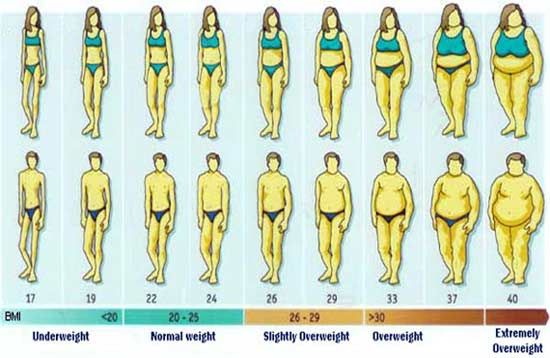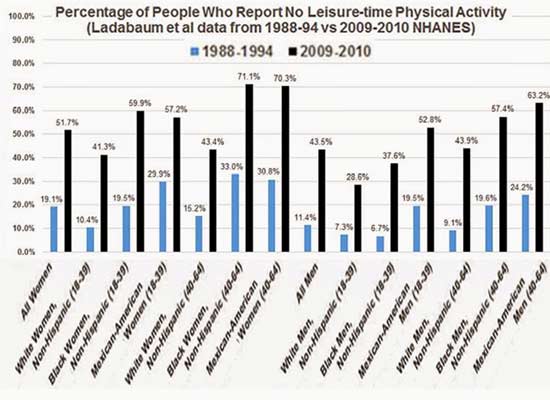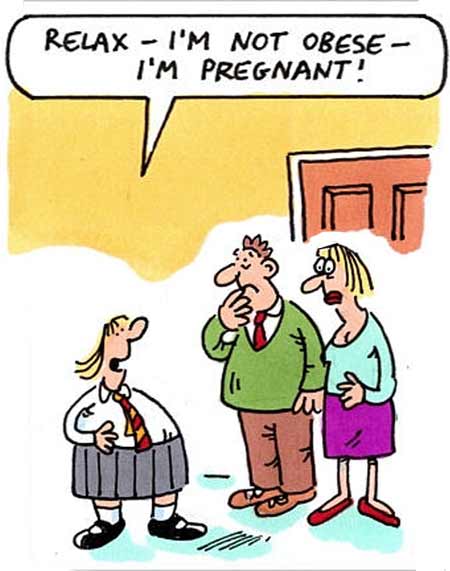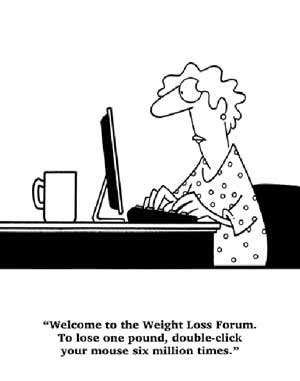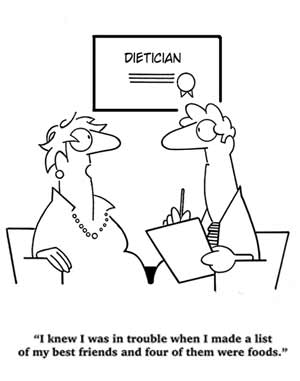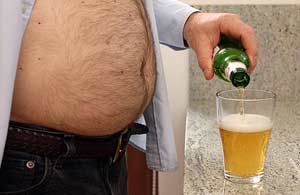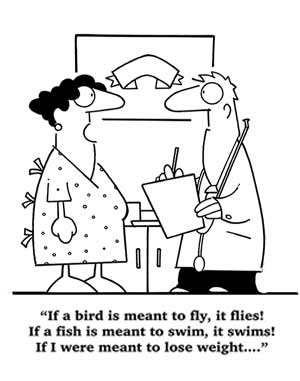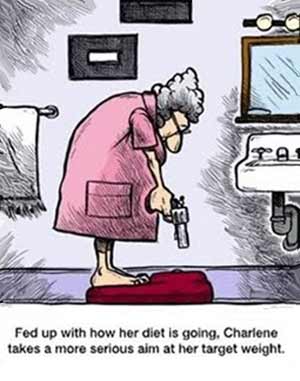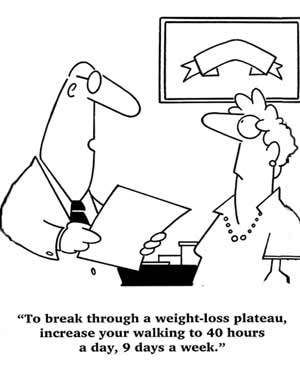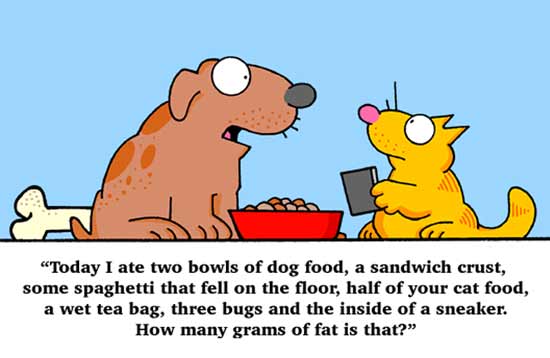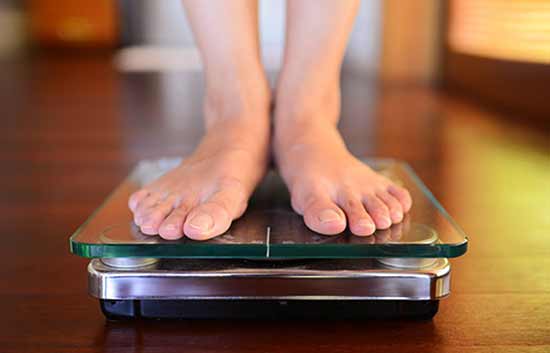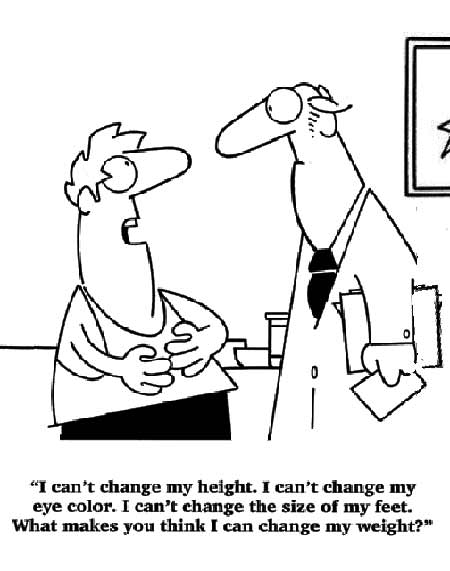I don’t need someone with a hot body.
He can be fat or overweight and have a belly.
It’s very much about style, substance, humour, interest, curiosity, and really being smart.
The Weight of the World
May 10, 2015
Note: This month’s post on obesity was itself overweight — too large for a single page.
The “Distillery” section which would normally follow this post is instead to be found on page 2, here.
Let’s play “what if” for a moment.
What if being overweight or obese isn’t a disease at all but merely a manifestation of a plentiful and time-saving environment? In nature, some of the seeds a plant produces have thin skins while others are thick-skinned. This is because the coming spring may be dry (only enough moisture for the thin-skinned seeds to sprout) or quite damp (the thin-skinned seeds have moulded but the thick-skinned seeds do nicely). Nature generally has a back-up plan. Why should humans be exempt?
Once food became plentiful, then epigenetic changes in the genome allowed humans to produce heavier offspring that could take maximum advantage of this (probably impermanent) situation. If food is NOT plentiful on a short-term basis in the future, these heavier offspring resist famine longer because internal fat stores that can’t be stolen see them through. If famine becomes the new norm, all offspring eventually become smaller, adapting to reduced resources. This has worked over millennia.
Some portion of the population being heavy has no doubt kept branches of the human race from dying out under adverse conditions many times in the past. Its success has allowed this characteristic to be widespread globally. Overall, it appears to be a positive human trait. And just because humans are heavy doesn’t mean they can’t be in good shape and healthy, just like any other body type.
The point is: Why is heaviness so unwelcomed by society?
A Bit of Background
To put this in context, the Western medical profession says that women should eat 1,600-2,000 calories per day and men 2,000-2,400, depending on age and activity.
Before we go further, consider this: a world where 40% of the population is 1 pound over the obesity line is clearly a different world from the one where 30% of the population is 100 pounds over the line (health outcomes would be worse in the latter case, in particular). While the latter has an obesity rate of only 30% compared to the former at 40%, the former group is nevertheless much healthier. The line above which is considered “obese” is a compromise, so figures should be guidelines only (though sometimes not treated as such).
- In the US, according to the Centers for Disease Control and Prevention (CDC), 69% of adults over 20 are overweight, including 35.1% who are obese (65% were overweight in NZ during the period 2011-2013, including 30% obese). That means about 80 million Americans are obese and 1.3 million Kiwis.
- In NZ, 68% of Pacific Islanders and 48% of Maori are obese.
- The number of obese children commonly rises from 12% at ages 2-5 to 18% at ages 12-19.
- The prevalence of obesity in Canada is 10% lower than in the US, in part because more young and middle-aged US women are obese than their Canadian counterparts; the magnitude of increases between the two countries over time remains similar.
- Apparently a 2012 report in the American Journal of Preventive Medicine estimates that 42% of US adults will be obese by 2030. (They say a linear time trend forecast suggests that figure may be closer to 51%, but reject it as “overstated given recent slowed growth”.)
- For comparison, 1.7% of US adults aged 20 and over are underweight (fewer men than women).
- An obesity prevalence map shows obesity is found in clusters.
70% of the variations in people’s weights may be accounted for by inheritance (more strongly inherited than mental illness, breast cancer, or heart disease). There are 32 known genetic variations that have been linked to obesity in humans. Those who are naturally fat have to constantly battle that inheritance to stay slim, meaning they’ll spend their whole lives hungry. At least some of them have something in their brains that compels them to eat. Whatever that drive is, it can be impossible to consciously control. Wanting to eat less only works for so long because eventually that drive, as powerful as the drive to drink water or even to breathe, takes over. In fact, some obesity can originate in damage to a tiny part of the brain, resulting in such insatiable appetites that people literally eat themselves to death. (Other animals can have this problem as well.)
By the way: Fat people who lose a lot of weight may look like someone who was never fat, but in fact they’re very different. By every measurement they seem like people who are starving. More than 50 people went through a month-long process of living at a hospital to ensure they lost weight. Every single one had physical and psychological signs of starvation by the end. The experiment was repeated several times with the same results each time. A very few in each experiment didn’t get fat again — but only those who made staying thin their life’s work (becoming Weight Watchers lecturers, for example), always counting calories and maintaining themselves in a state of semi-starvation.
Some countries have taken various measures to reduce obesity rates such as:
- Dubai — Citizens get paid to lose weight.
- New Zealand — Overweight immigrants are barred from obtaining Visas.
- China — Acupuncture is the treatment option for obesity (and has been for centuries). Since fewer Chinese are obese, does that mean it works? (Not really.)
- Japan — Only 3.5% of Japan’s population are classified as obese. In 2008, the government initiated a policy establishing waistline limits for adults aged 40 – 74. Everyone must be at or below 33.5 inches for men and 35.4 inches for women. By law, companies measure and report waist circumferences for every employee 40 – 74 years old. Anyone falling out of mandated limits is required (among other things) to attend counselling and support sessions. (Perhaps this measure is super-effective or perhaps isolated Japan is later than other countries in developing the epigenetic changes leading toward heaviness. Perhaps it’s mainly that the Japanese have slender body types — although Japanese who immigrate to the US do become heavier and taller.) Passing the waist test is required to qualify for health insurance.
Leptin and ghrelin are two human hormones recognised to have a major influence on energy balance.
- Leptin suppresses food intake and makes people want to stop eating. Without leptin, the appetite is insatiable — some people find that they just never seem full. This is not a psychiatric problem but a very powerful biological effect.
- Ghrelin on the other hand is a fast-acting hormone that makes people hungry so they seek something to eat. Ghrelin also plays an important role in regulating reward perception in dopamine neurons, thus playing a role in sexual desire and in addiction.
In obese subjects (oddly) the circulating level of leptin is usually higher than normal, indicating that their bodies are not responding to this stop-eating signal. Yet the amount of ghrelin is less than normal, indicating that their bodies are hyper-sensitive to signals to start eating. (But what is the cause, and what is the effect, of overeating?) The exposure of the hypothalamus to high leptin levels may damage it — or a defect in leptin receptors cause altered sensitivity (also possibly caused by defects in downstream mediators). When obese patients lose weight, ghrelin levels show an increase, as if the body is attempting to compensate. In a study of 12 young men, sleep deprivation was associated with increases in ghrelin levels (and hunger) compared to sleeping 10 hours a night.
Why does eliminating obesity seem so important? Believe it or not:
- It can’t be done.
- A report by the consulting firm McKinsey & Co predicted in May 2012 that “health and wellness” would soon become a trillion-dollar global industry. It added, with a consultantly chuckle, “and dealing with it is a big, fat market.”
- The health effects of obesity are not as clear-cut as generally presented.
These points will be separately addressed.
Obesity Can’t Be Eliminated (at Least with the Tools We Have Available Today)
What influences obesity? That would be diet, nutritional status, and influential social conditions; the bacteria and viruses ingested and incubated; the drugs and medicines taken; the cigarettes smoked; the artificial sweeteners consumed; the cleaning products smelled; the random chemicals absorbed from food, air, water and soil, at work, at home, and in consumer goods; the stress endured from jobs, families, socioeconomic and racial privileges, traumas, and traffic jams; the energy expended; the amount of restful sleep available; and self-image. All this overlays the body’s starting point: genes and their various epigenetic controls.
So do we reinforce the present obsession with individual behaviour being the primary cause for any failures someone may have in presenting a standard-weight body to the world? Evidence indicates that losing weight and keeping it off is significantly difficult for almost everyone but much worse for some and impossible for a few. Options include constant dieting, frequent exercise, behaviour modification, drugs, spas, hypnosis, fasting, and ultimately surgery — and probably all of them over time.
Or we can go the acceptance route. Understanding, tolerance, and more money for research would help with this global problem, which has proven to be much more complex and widespread than most people have realised. There are 671 million obese people in the world (some estimates go as high as 2 billion). The big picture is clear: The world is getting heavier. Records show that since 1980, the number of overweight and obese adults has shot up by more than 27%. (One easy solution? Redefine obese.)
The saga of people’s unending attempts to control their weight is a tale of science and society, of social mores and social sanctions, of politics and power. It raises questions of money and class, and of whether there is such a thing as free will when it comes to eating and body weight. It raises questions of how and why the discoveries of science, which have slowly chipped away at the reasons for obesity and the real health effects of being overweight, have been shunted aside by marketing and hucksterism and politics.
And it is a story of the secret world of the overweight, who fantasize about finally, at long last, getting thin. What is it like to know the calorie count of every morsel of food you see and to worry that a single spoonful of ice cream or a cube of Swiss cheese can send your eating spiralling out of control? What is it like to face, as the National Academy of Sciences so bluntly puts it, a “continuous lifelong struggle with no expectation that the struggle required will diminish with time”? And how did our society today end up with what may be the greatest disconnect ever between body weight ideals held up as obtainable (if you really try) and body weight realities for most people?
Source: Rethinking Thin by Gina Kolata, Picador, New York, 2007, page 7.
No single thing is the cause of obesity, but taken together, the effects can be large. Its root cause, proposed last year by Jonathan C K Wells in the American Journal of Human Biology, is nothing less than the history of capitalism. Capitalism welcomes the fast-growing ranks of the world’s 21st-century middle-class consumers, thanks to globalisation and outsourcing: these descendants are now prime targets to live the obesogenic life (which includes chemicals, stress, spending long hours in front of a computer, air conditioning, and elevators), buying the kinds of foods and beverages that are metabolic disturbers. Moreover, obese people pass on changes in metabolism epigenetically to their children that can predispose them to obesity as well.
Source: “The Obesity Era” by David Berreby, Aeon, 19 June 2013.
In 1945 (during World War II), Britain found that on a ration of 2,900 calories per day, adults on average kept a steady weight. Anything less than that led to weight loss and protests; 3,000 calories led to weight gain. In 1948, 2,387 calories per capita were recorded, but this excluded alcohol, confectionery, soft drinks and eating out. However, by 2012, despite all of the above now being included in the figures, recorded consumption was 2,209 calories per capita, which is to say it was lower than the 1948 figure. (The British government currently suggests adults consume 2,250 to maintain a healthy weight.)
In fact, between 2002 and 2012, average caloric intake in Britain fell by 8%; continuing a trend that has been ongoing since 1960. Yes, Britain has been getting fatter since 1960, but they’ve also been eating less. People are eating less than they used to, but not enough less. US data also suggests calorie intake is falling and that female obesity has been flat since 1999 or so.
Obesity prevalence is clearly much higher today than it was in 1948 and it seems clear that the primary reason for this must be a big decline in physical activity, whether it be in the workplace, in the home, or in personal transportation. While “energy in” has gone down, “energy out” has gone down even more.
Fat people aren’t fat because they have no willpower or because they’re somehow morally inferior to skinny people. Most are fat because their weight, like their height, is genetically predetermined (some people are just destined to fat). People tend to have set body weights (weight lost is almost always regained) and genetics and biology play a bigger part in weight gain than eating habits. Studies that show these things are always buried by the “common knowledge” that obesity is a result of a lack of willpower and self-control, that fat people are simply lazy. Person after person struggles to diet and lose weight, but as soon as they stop dieting, they regain any weight they lost.
Since the majority of people in the world (certainly the Western world) now weigh too much while living in cultures where weighing “too much” is met with harsh social criticism, poverty, job discrimination, low self-image and more, if diet and exercise are all that’s required to achieve the ideal weight, why aren’t more people thinner than they are? Because weight loss that’s significant and permanent requires being on a diet for the rest of their lives. There aren’t too many people who can manage that. It means obsessively eating less than they want, and little or none of what they’d like to eat, forever. Nevertheless, 115 million Americans are dieting on any given day in hopes that their experience will be different.
- In a typical research setting lasting two years, a low-carbohydrate diet was compared to a calorie-counting diet. Both groups got support and counselling and the end result for both was the same. They all lost weight. Then they all put it back on.
- In another study, a group of skinny men (prisoners) volunteered to get fat. They all did, but it was difficult because they had to overcome their natural metabolism — the more they ate, the more it sped up. Some ended up eating 10,000 calories a day. Another group of overweight men in the same setting volunteered to instead lose weight. The more they lost, the more their metabolism slowed. When the thin men got fat, their metabolism increased by 50%. They needed more than 2,700 calories per square metre of their body surface to stay at their obese weight, but just 1,800 at their normal weight. The obese people who had got that way naturally on the other hand, couldn’t eat more than 1,800 calories per square metre or they began to gain weight. When the study was over all men returned to their pre-study weight without effort. We can move back and forth across the set point our bodies try to maintain within 10-20 pounds by over- or under-eating, but it requires constant vigilance to stay outside those parameters.
In one massive study sponsored by the National Institutes of Health, more than 5,000 kids were followed from the 3rd grade to the 5th grade. Half were given healthy food, nutritional advice, and extra physical activity. The other half were not. At the end of 3 years, there was no measurable difference between the two groups.
Does this set point apply to creeping weight gain? I could find no studies that applied specifically to those who gain 10-15 pounds per decade throughout adulthood. Research shows that people tend to have set weights and can gain or lose 10-15%, but will stay within that range. That seems to contradict a creeping gain.
Dr David Ludwig, director of the Optimal Weight for Life program at Children’s Hospital Boston: “An obese adolescent who cuts back TV viewing from 6 to 5 hours each day may then go on to decrease his viewing much more. However, it would be entirely unrealistic to think that these changes alone would produce substantial weight loss.” Why not?
The answer lies in biology. A person’s weight remains stable as long as the number of calories consumed doesn’t exceed the amount the body spends on exercise and to maintain basic body functions. As the balance between calories going in and calories going out changes, we gain or lose weight.
But bodies don’t gain or lose weight infinitely. Eventually, a cascade of biological changes kicks in to help maintain a more constant new weight. A person who eats an extra cookie a day will gain some weight, but over time, an increasing proportion of the cookie’s calories goes to taking care of that extra body weight. Eventually, the body adjusts and stops gaining, even if the person continues to eat the cookie. Similar factors come into play when we skip the extra cookie. We may lose a little weight at first, but soon the body adjusts to the new weight and requires fewer calories.
Regrettably, the body is more resistant to weight loss than weight gain. Hormones and brain chemicals that regulate the unconscious drive to eat and how the body responds to exercise can make it even more difficult to lose the weight. A person may skip the cookie but unknowingly compensate by eating a bagel later or an extra serving of pasta at dinner.
“If you ask anyone on the street, 'Why is someone obese?’ they’ll say, 'They eat too much.’ That’s undoubtedly true,” he continued, “but the deeper question is why? There are many drivers to eat and it’s not purely a conscious or higher cognitive decision.”
Source: “In Obesity Epidemic, What’s One Cookie?” by Tara Parker-Pope, The New York Times, 1 March 2010.
The Hope of Weight Reduction Fuels a Very Large Industry
There is a strong social bias against obesity fed by the media (a script may call for a fat sidekick who is amusing, but the protagonist is always thin), and even by the medical profession (with much less justification than you might suppose).
From Britain’s Daily Mail (undated):
Fat families are to be prescribed a visit to their local Sainsbury’s by GPs, where they will be taken by the hand and shown healthy foods.
The supermarket has struck a deal with family doctors and the drug firm Roche under which overweight patients will be offered tours of selected stores with advice from nutrition experts.
That’s surprisingly insulting. So if you’re overweight or obese, you must be thick in the head as well? There are special interests behind the politics of obesity that are hyping it beyond its actual severity. And why not? There’s money to be made.
What are the social drawbacks of being obese?
- Being judged by people. Everyone thinks you’re fat because you eat too much or don’t exercise.
- Not being able to indulge in food, being unable to eat the food you like while slimmer friends / family / colleagues hog on desserts, fried food, high carb foods, and salty foods but you can’t do that as you gain weight very quickly.
- Health problems.
- Not being able to find fashionable clothes in your size.
- Constantly having to change your wardrobe as you keep gaining weight, then losing some, then gaining even more.
- Difficulty in getting the opposite sex to find you attractive, difficulty in finding a date, or finding a life partner.
- Lower stamina, feeling tired all the time.
- Severe pain in the feet because of having to carry around so much extra weight.
- Unappealing stretch marks.
- Getting teased in school, in college… random comments while walking on the street.
- Being considered less effective at work just because you’re obese.
- Obesity-related depression.
- Skin allergies in the folds of skin.
- Low self-esteem after encountering all of the above.
Obesity is expensive. Healthcare is expensive. Changing your wardrobe is expensive. Visiting doctors / dieticians / health food stores / gyms… all that is expensive.
Source: “What is it like to be morbidly obese (BMI > 40)?” on Quora, anonymous post, last accessed 25 April 2015.
The weight-management industry is approaching $700 billion annually and still growing robustly. What if everyone stopped worrying about weight? Little chance of that happening! In one classic study an obesity researcher asked 47 formerly-fat men and women whether they would rather be obese again or have some disability.
- Every one said they’d rather be deaf or have dyslexia, diabetes, bad acne, or heart disease than to be fat again.
- 91% said they’d rather have a leg amputated.
- 89% would rather be blind. (One said, “When you’re blind, people want to help you. No one wants to help you when you’re fat.”)
- 90% of respondents in another survey said that friends or relatives had ridiculed them or made nasty comments about their weight.
- 75% said they’d been laughed at or derided by fellow employees.
- One of the survey participants wrote, “While attending a lecture in college, a professor stopped speaking in the middle of a sentence and said, 'When are you going to lose weight? You’re really fat.’ There were over 100 people in the class.”
- 25% of fat men and 16% of fat women reported being hit or threatened because of weight.
- 33% said they’d been derided by health professionals.
- 25% said they’d been refused treatment because they were fat.
Source: Rethinking Thin by Gina Kolata, Picador, New York, 2007, page 69.
About 23% of people in 2012 said that those who are not overweight look a lot more attractive, down from 55% who thought that in 1985. Perhaps people may be becoming more accepting of their weight because that’s easier than trying to exercise and eat less.
Another recent study, from the International Food Information Council Foundation, showed that about 55% of people are trying to drop some weight. The desire to lose weight is much greater than the percentage of people who are on a diet — almost 60% of adults want to lose at least 20 pounds. In 2012, 26% of all dieters said they followed a diet for less than a month; 36% for 1-6 months; 11% for 7-12 months; 27% for more than a year, and 9% for more than 5 years.
Just How Unhealthy Is Obesity?
Body mass index (BMI) is weight in kilograms divided by height in metres squared. It’s widely accepted as an appropriate population-level indicator of excess body fat. Waist circumference (WC) is an alternative anthropometric measure that additionally indicates whether excess body fat is centrally or peripherally located. Most studies in New Zealand and internationally have examined only obesity prevalence, rather than the full population BMI or WC distribution, yet the definition of “obesity” is based on an arbitrary threshold of BMI. (By the way, BMI and waist circumference trends are associated with physical activity level but not caloric intake. Obesity and abdominal obesity are associated independently with morbidity and mortality but physical activity attenuates these risks. Furthermore, a recent survey found that 80% of 2,117 adults questioned did not know the calorie content of common drinks, and most were completely unaware that alcohol contributed to the total calories that they consumed. “Calories from alcohol” is rarely included in lifestyle and obesity assessments.)
The extreme importance that there be a “fight against fat” is generally presented as one that will improve health. And indeed, according to the NZ Ministry of Health (NZMOH), obesity in children is associated with impaired glucose tolerance and high blood pressure at a younger age and also musculoskeletal problems, asthma and psychological problems including body dissatisfaction, poor self-esteem, depression, and other mental health problems. There’s a long list of adult health conditions including Type 2 diabetes, ischaemic heart disease (IHD), stroke, several common cancers, osteoarthritis, sleep apnœa and reproductive abnormalities. NZMOH says that the impact of excess body weight on these diseases operates, at least in part, through its effects on insulin resistance, blood glucose, blood lipids, and blood pressure.
They further state:
Although some people are more genetically susceptible to weight gain than others, the rapid increase in the prevalence of obesity in recent years has occurred too quickly to be explained by genetic changes and most experts believe it is due to living in an increasingly “obesogenic” environment – one that promotes over-consumption of food and drinks and limits opportunities for physical activity.
Curiously, neither the NZ report (see “Understanding Excess Body Weight” in Sources below) nor the CDC Morbidity and Mortality Report seems to bear that out. The CDC says that obesity rates remained level while age-adjusted rates declined among all leading causes of death. Nowhere in either report could I find any comparisons of the death rates of obese versus non-obese. (Perhaps if you die and you’re obese then that must’ve been the cause?) The CDC says, “…obesity-related health issues that impact chronic disease rates and deaths continue to be a challenge…” and also that “Certain indicators represent health outcomes or chronic conditions with causal links to the leading causes of death (i.e., obesity and uncontrolled high blood pressure, high cholesterol, and diabetes) are shown in Table 3” — but Table 3 only shows the prevalence of obesity. There’s nothing showing that the non-obese are healthier. For example, they show the percentage of adults who meet the federal physical activity guidelines (a mere 16.6%). Nowhere does it say what percentage of those are or are not obese. Other NZ reports are similar.
According to the World Health Organization, “Overweight and obesity are defined as abnormal or excessive fat accumulation that presents a risk to health.” If more than half (52%) of the global population is overweight or obese, I fail to understand how it could be called abnormal when in today’s world it’s apparently normal to weigh more than in the past. At any age, those born in more recent decades are more likely to be obese than those born in earlier decades, so a trend is clear.
According to The Obesity Myth (see Sources below):
There is at present little or no credible medical evidence that, for all but a small percentage of Americans, increased weight represents a significant independent health risk. Being heavier than average may be a sign of the presence of other factors that are health risks, especially a lack of physical activity, but there is no real evidence that weight itself causes undue health problems, at least not until one reaches the level of body mass that is more than 100 pounds above the average for a person of a particular height.
…the reason why it isn’t known whether people who lose weight and keep it off acquire the health risks of people who have always been thin is that … there is no known method to get a statistically significant group of fat people to lose weight and keep it off. … And the evidence has become compelling that this process of attempting to lose weight and failing to do so is far more damaging to health even than maintaining very high weight levels…
But do Americans try to lose weight primarily in an attempt to improve their health? There is a great deal of evidence that health concerns play an insignificant role … because much of the public is willing to run serious health risks in the pursuit of cosmetic weight loss.
Some women say they’d rather get hit by a truck than gain 100 pounds. (Really? It’s that bad? It seems like it would be easier to lose weight than to return from the dead, but maybe they know something I don’t.)
People who keep a log of every bite they eat usually find that they eat a lot more each day than they think. What this often means is that no matter what the diet and no matter how hard they try, they just may not be able to lose a lot of weight and keep it off. They can lose a lot of weight and keep it off briefly, they can lose some weight and keep it off for a longer time, they can learn to control their eating, and they can learn the joys of regular exercise. Those who do best keep their homes free of any foods they can’t resist. This lifelong effort can be rewarding. But true thinness will almost certainly elude them and maintaining their weight will take a LOT of daily attention and control.
There’s prejudice against fat people both in the media and in the scientific community. Almost everyone who is overweight has been told by one or more doctors that their problems will go away if they’ll only eat less and exercise more. Yet the claim that overweight people die younger simply isn’t borne out if one looks closely at study details. In fact, more rigorous studies reveal the opposite — overweight people can live longer. But there are exceptions for the morbidly obese or for those whose only fat is metabolic syndrome (typically evidenced as a “beer belly”). Metabolic syndrome is a disorder of energy utilisation and storage, diagnosed by a co-occurrence of 3 out of 5 of the following medical conditions:
- abdominal (central) obesity (also known as visceral, male-pattern, or apple-shaped adiposity)
- elevated blood pressure
- elevated fasting plasma glucose
- elevated fasting serum triglyceride level (VLDL triglyceride)
- decreased fasting serum HDL cholesterol levels
Another common sign is insulin resistance, or pre-diabetes, as metabolic syndrome increases the risk of developing cardiovascular disease and diabetes. Some studies have shown the prevalence in the USA to be an estimated 34% of the adult population (44% of those older than age 50). But it should be noted that patients who are of normal weight may also be insulin-resistant and have metabolic syndrome. Therefore, it’s likely that obesity isn’t the cause — or certainly not the only cause.
A pooled-analysis of 5 longitudinal cohorts tracking a total of 2,625 people over 40 years old with type 2 diabetes found that although only 9-21% of the participants were normal weight (<25 BMI), the normal-weight people had twice the chance of dying during the study than the overweight / obese participants. In all BMI categories there is variability in terms of health. Obesity is unmistakably growing and certainly affects the quality of life, but in some instances it’s inexplicably prolonging it.
Being obese (a technical term) is a risk factor for having a stroke. This means being clinically obese makes it more likely that you’ll have a stroke. The fat on your body does not literally cause the stroke, but only a fool in a family with a history of heart disease would conclude that obesity is perfectly safe.
Americans are overweight, but the reason for the recent publicity campaign is a psychological softening up campaign in preparation for the ACA in 2014. A little-known provision in the ACA permits a group health insurance surcharge of 50% for being overweight. The contribution of a single (non-family) overweight employee will increase 250%, from $100/month to $350/month. The surcharge is 50% of total policy cost, not the employee’s contribution. Average policy cost in 2012 was $500/month, so the surcharge is 50% of 500 = $250.
More than half of Americans are overweight (BMI > 25). HIPAA now requires all employees be charged the same. The only exception is a 15% surcharge for smokers, and employers must jump through bureaucratic hoops to offer cessation classes before charging extra. The ACA expands the definition of lifestyle issues, removes the requirement for remediation, and greatly increases the surcharge.
Source: “Is America’s obesity epidemic for real?” on Quora, post by Robert Wagner, 25 January 2013.
Sidebar: Animals Are Also Getting Fatter for Many of the Same Reasons
Consider this troublesome fact reported in 2010 by the biostatistician David B Allison and his co-authors at the University of Alabama in Birmingham: over the past 20 years or more, as the American people were getting fatter, so were America’s marmosets. As were laboratory macaques, chimpanzees, vervet monkeys, and mice, as well as domestic dogs, domestic cats, and domestic and feral rats from both rural and urban areas. In fact, the researchers examined records on those 8 species and found that average weight for every one had increased.
The marmosets gained an average of 9% per decade. Lab mice gained about 11% per decade. Chimps, for some reason, were doing especially badly: their average body weight had risen 35% per decade. Allison, who had been hearing about an unexplained rise in the average weight of lab animals, was nonetheless surprised by the consistency across so many species. “Virtually in every population of animals we looked at that met our criteria, there was the same upward trend,” he said. The trend suggests some widely shared cause, beyond the control of individuals, which is contributing to obesity across many species. The monkeys’ diets had been changed over the years, a switch that was well-documented by the lab. So Allison tried running the numbers again, this time controlling for the diet change. “It only made the results stronger,” he said. With the diet change, the animals should have lost weight, if anything.
Obese people have a less diverse array of bacteria living in their guts than do thin people — and the same holds true for dogs. And a virus called adenovirus 36 (AD36) has been linked to obesity in both humans and animals. AD36 raises body-fat levels in animal models such as chickens and rodents. What’s more, obese humans were 3 times more likely to be infected with the virus than non-obese people — and heavier individuals in both groups tended to be infected.
Obesity affects about 40% of African elephants in captivity, and it’s common to see overweight or even obese lemurs in captivity. Dolphins at Japan’s Kinosaki Marine World grew too plump to jump. A similar difficulty arose in a Shanghai aquarium when the sharks got so tubby that keepers gave them fish stuffed with cabbage to help them slim down. Overfed horses become overweight. Some carnivorous reptiles such as leopard geckos are voracious eaters and easily become obese. Skunks are extremely prone to obesity in captivity. Rabbits, guinea pigs, hedgehogs, and chinchillas seem particularly prone to unhealthy weight gain and can become obese if overfed.
Rates of overweight in dogs in the US range from 23% to 41% with about 5.1% of them obese. Rates of obesity in cats was slightly higher at 6.4%. In Australia, the rate of obesity among dogs in a veterinary setting has been found to be 7.6%. The risk of obesity in dogs but not cats is related to whether or not their owners are obese. The primary reasons for obesity in pets is overeating and a lack of physical exercise. In wealthier countries, many can afford to give their pets excessive amounts of food. Owners view food as a way to reward and treat their pets, which contributes to their overeating habits. Modern-day pet foods are of a higher quality, and some pets are prone to gorging themselves to the limit of their stomach capacity, a behaviour developed through evolution.
Penguins are said to be so full of fat that they can be used to fuel a fire. And aren’t harbour seals just big blubbery sausages-of-the-sea? Bears eat like crazy in the summer and are fairly chubby in the autumn. But then come the hard times. Their surplus fat is burned surviving the winter. (That’s how it should work with humans, too.) A bear has to eat readily digestible food like humans do. When one comes across lots of food, it stores the surplus as fat. Humans are actually a tropical animal species adapted to an environment with little food, programmed to put on weight to make it through famine. But now there’s seldom famine. If humans still lived out in nature like other mammals, they’d reach an age of 25-30. Studies of Cro-Magnon humans and Neanderthals show that few passed the age of 35. In those 2-3 decades they hardly had time to develop cardiovascular disorders. But the human environment has changed so much that the body’s storage functions are causing problems. But time should cause an adjustment (like it always does).
What Is Being Done?
- The MAESTRO System is a pacemaker-like device designed to control hunger and fullness by blocking the vagus nerve (which extends from the brain to the stomach). The system us called the VBLOC and doesn’t alter the stomach or intestine like weight loss surgeries do. The US Food and Drug Administration approved it in January.
- The ReShape Duo, a double balloon filled with saline, is placed in the stomach for 6 months and is intended to help people feel full. It’s been on the market in Europe since 2007 and is now under FDA review. Nearly all patients have nausea, vomiting, and abdominal discomfort in the first few days, but the symptoms usually go away in about a week.
- The Elipse Balloon has been revised several times. The goal is for it to be placed in the stomach and later removed, both without endoscopy, a procedure usually requiring sedation and a specially-trained doctor. It’s attached to a long, thin, flexible tube. The balloon is swallowed, then filled with about 15 ounces of water and the tube pulled out. In its first human test, it remained full for 6 weeks in 6 of 8 people, then emptied and was expelled from the body. It’s undergoing clinical trials in Europe and should launch by early 2016.
- The Obalon Balloon works a little differently. First, a capsule is swallowed that contains a balloon. The capsule dissolves and the doctor inflates the balloon through a tube attached to it (now hanging out of the patient’s mouth). The doctor then removes the tube. Up to 3 balloons can be emplaced during the 12-week treatment. Then they’re all removed (how wasn’t specified). The device is approved in several countries in Europe and in Mexico. Clinical trials in small US cities begins soon.
- EndoBarrier is a thin, flexible liner placed at the beginning of the intestine. It’s left in place for a year before removal. Because it blocks food from a portion of the intestinal wall, it’s designed to alter the release of hormones that play a role in digestion. It’s not available in the US, but is on the market in several other countries.
- Beloranib allows the patient to burn off stored fat without feeling hungry, says Zafgen, the Boston company that developed the drug. The first drug of its type, it’s given in twice-weekly injections. Patients are said to convert less of the calories they’re eating into stored fat and it also stimulates the burning of fat already stored. Zafgen is seeking approval for 3 conditions: Prader-Willi syndrome (a genetic disorder that causes unstoppable hunger and profound obesity); “acquired Prader-Willi syndrome,” which results from the treatment of benign tumours in the middle of the brain; and severe obesity complicated by type 2 diabetes.
- Mirabegron, approved by the FDA in 2012 as Myrbetriq to treat an overactive bladder, might also help people lose weight. It works by activating a protein on bladder cells that is also found on fat cells. A study funded by the National Institutes of Health tested showed that it could activate brown fat, a type of body fat that creates heat by burning calories. A single high dose raised the metabolic rate in 12 thin young men by an average of 13%. It will next be tested on obese people.
- Fasting can lower blood pressure, reduce excess fat and glucose in the blood, modulate the immune system, increase the effects of the neurotransmitter serotonin (which regulates mood and sleep), boost protein repair, and reduce inflammation. Fasting has been likened to a “reset” button that returns the human body to its healthy factory settings. A study published last year in the US concluded that 3 days of fasting can rejuvenate the immune system, triggering the production of new white blood cells. Other studies show that it can enable healthy cells to endure better the toxic impact of chemotherapy (and it makes cancer cells die more rapidly). It draws on the body’s evolutionary adaptation: in the absence of carbohydrates, fatty acids from the body’s stored fat supplies are broken down in the liver to produce molecules known as ketone bodies, which are used for fuel. Preliminary evidence says fasting may help in Parkinson’s, multiple sclerosis and Alzheimer’s. It’s therapeutically efficient, safe and (perhaps surprisingly) easier than dieting for some.
- Anticipated weight loss approaches include, but aren’t limited to, the following:
o Suppression/Inhibition of fat absorption
o Promotion of fat decomposition and combustion
o Suppression of appetite and promotion of a feeling of fullness
o Bowel evacuation delay
o Gastric distension effect
o Promotion of energy consumption (Improvement of metabolism)
Conclusion
To the beanpole dames in the magazines:
You ain’t it, Miss Thing!
Give me a sister, I can’t resist her
Red beans and rice didn’t miss her.)
— Sir Mix-a-Lot
The genetic correlation with weight is higher than that with many other things we think of as “genetic” such as mental illness or cancer. Most diets don’t work, especially in the long term. By and large, fatness or thinness has nothing to do with psychological state of mind or self-discipline or morals. In the current climate of hysteria about weight and obesity, that message needs to be heard. Maybe humans are just evolving to be larger and heavier. Different bodies require different amounts of food. Cholesterol, triglyceride, and blood pressure levels are better indicators of health than weight. Overweight people who eat healthy foods and exercise can be healthy.
Men (who can be critical of women for their weight) are actually the fatter sex as defined by BMI. Just 36% of men over 18 are at a healthy weight and a mere .09% are underweight. In comparison, 49.5% of American women aged 18 or older have a normal BMI.
- If your parents or relatives are overweight, you’re more likely to be.
- It’s nearly impossible for people who are extremely overweight to lose the weight permanently without resorting to surgery.
- People who are overweight and then lose great amounts of weight are usually never sated, no matter how much they eat.
- Our notions of weight and overweight are not always grounded in science. Being overweight need not mean you’re less healthy.
- Generally, each person has a destined weight range, and can gain or lose 5 to 20 pounds, but probably won’t take off more than that permanently.
If you want to live a long and healthy life, then eat right and exercise. And stop hoping to lose weight. The cure for the disease of obesity is to realise that it doesn’t exist. The consensus is that overweight is unattractive and the unattractive is consistently avoided. But we simply must become less interested in surface and illusion. Accept the increase in human weight with grace. Yes there are health detriments to being overweight, but since a majority of humans ARE overweight, why not be pragmatic?
It’s also hazardous to be short — short people are at greater risk of heart attack. For 60 years scientists noted a correlation between height and coronary heart disease but thought it was due to social factors such as poor nutrition in childhood, which could stunt height and explain why petite people were more likely to develop heart problems. But a new study found that every 2.5-inch-difference in height between two people makes the shorter person 13.5% more likely to develop heart disease. There are also prejudices against people that are short. But how does that help anyone?
Thin people think because they can skip a meal and merely feel a bit hungry, that everyone can do the same. But the sensation of hunger is very different for some — it can be an overpowering sensation (the “pangs” of hunger can actually be painful). Fat people are fat because their drive to eat is very different from thin people. The whole issue of appetite and weight regulation in humans is at the interface of free will and determinism. Hormones affect not only how hungry we are, but can also affect the very wiring of our brains. Some people may think they’re thin because they’re morally superior when in fact they’re just genetically lucky.
Higher weights can be an unintended consequence of generally better health or sometimes even a contributor to it. Maybe whatever is pushing up the average weight of humans might be for the best and the lesson is that we’ve been looking for answers to the obesity “epidemic” in the wrong places. At the very least, it doesn’t help to tell people that they’re fat (as if they didn’t already know). Even Oprah gained her weight back and she had a personal chef, personal trainer, and the whole world watching.
If the human race is moving in the direction of being heavier and heavier (like the people in Wall-E) what then?
- We could follow Japan’s lead and keep the very obese under constant surveillance. We could even send them an electric shock when they reach for the wrong food. But would you really want to live in such a country?
- We could be accommodating. This means we’ll need larger seats, sturdier furniture, special equipment in hospitals, etc. Yes, this will be costly, but people are already overweight. This needs to happen regardless, unless a better solution is found quickly.
- More money could be allocated to research.
Severely obese people likely suffer a great deal and would change if they could. Other than the fact that they weigh more than you, they are otherwise quite normal (or in some cases quite exceptional) people. What’s hardly an effort for you may be a life-threatening ordeal for them. Perhaps you have a problem with alcohol but they don’t. Everyone has something they’d like to change. (Or to hide.) Fat shaming is cruel and inhuman and reflects very badly on the perpetrators. I myself wear an eye patch and I’m sick and tired of strangers calling me a pirate, then asking probing personal questions. Please read a book on manners if you can’t control your urge to blurt.
Yes, some fat people may be malingerers. So what? So are a lot of skinny people.
Sources
“Association of weight status with mortality in adults with incident diabetes” by M R Carnethon, P J de Chavez, M L Biggs, et al, JAMA: the Journal of the American Medical Association, 8 August 2012.
“Big Bird” by David Merritt Johns, Slate, 17 April 2012, http://www.slate.com/articles/health_and_science/science/2012/04/animal_obesity_are_pigeons_getting_fatter_.html.
“Big wine glasses are adding to weight woes” by Sarah Knapton, Stuff, 30 April 2015, http://www.stuff.co.nz/life-style/well-good/teach-me/68141829/big-wine-glasses-are-adding-to-weight-woes.
“Calorie consumption revisited (part 1 of many) by Christopher Snowdon, Velvet Glove, Iron Fist, 18 September 2014, http://velvetgloveironfist.blogspot.cz/2014/09/calorie-consumption-revisited-part-1-of.html.
“Calorie consumption (part 2 of many) by Christopher Snowdon, Velvet Glove, Iron Fist, 29 September 2014, http://velvetgloveironfist.blogspot.cz/2014/09/calorie-consumption-part-2-of-many.html.
“Can wild animals become overweight?” by Ingrid Slilde, ScienceNordic, 26 November 2011, http://sciencenordic.com/can-wild-animals-become-overweight.
“Embodying Social Rank: How body fat varies with social status, gender and ethnicity in New Zealand”, Public Health Intelligence Occasional Bulletin No. 34, Wellington: Ministry of Health, 2006, http://www.health.govt.nz/publication/embodying-social-rank-how-body-fat-varies-social-status-gender-and-ethnicity-new-zealand (to download).
“Fasting could help us cope with a number of diseases” by Liz Hunt, Stuff: well&good, 16 April 2015, http://www.stuff.co.nz/life-style/well-good/inspire-me/67744102/fasting-could-help-us-cope-with-a-number-of-diseases/.
“Fatty Liver” from Wikipedia, last accessed 24 April 2015, http://en.wikipedia.org/wiki/Fatty_liver/.
“Fewer people say they’re on a diet” by Nanci Hellmich, USA TODAY, January 7, 2013, http://www.usatoday.com/story/news/nation/2013/01/07/decrease-dieting-weight/1814305/.
“Food Materials Effective in Weight Loss” from NineSights / Nine Sigma, last accessed 24 April 2015, https://ninesights.ninesigma.com/rfps/-/rfp-portlet/rfpViewer/2766?utm_source=Reminder&utm_medium=email&utm_campaign=0276639&utm_source=SilverpopMailing&utm_medium=email&utm_campaign=REQ0276639%20-%20Food%20Materials%20Effective%20in%20Weight%20Loss%20-%20Reminder%20(1)&utm_content=&spMailingID=22461117&spUserID=OTUxMjQ0NDI2NDYS1&spJobID=541045887&spReportId=NTQxMDQ1ODg3S0.
“Ghrelin” from Wikipedia, last accessed 26 April 2015, http://en.wikipedia.org/wiki/Ghrelin.
“Guts of obese dogs look similar to those of obese people” by Agata Blaszczak-Boxe, Science, 25 November 2014, http://news.sciencemag.org/health/2014/11/guts-obese-dogs-look-similar-those-obese-people.
“Is America’s obesity epidemic for real?” on Quora, last accessed 25 April 2015, http://www.quora.com/Is-Americas-obesity-epidemic-for-real/.
“Metabolic Syndrome” from Wikipedia, last accessed 24 April 2015, http://en.wikipedia.org/wiki/Metabolic_syndrome.
“Obesity in Exotic Animals” from the Oregon Veterinary Medical Association, last accessed 26 April 2015, https://oregonvma.org/care-health/obesity-exotic-animals.
“Obesity in Pets” from Wikipedia, last accessed 28 April 2015, http://en.wikipedia.org/wiki/Obesity_in_pets.
“Obesity, Abdominal Obesity, Physical Activity, and Caloric Intake in US Adults: 1988 to 2010” by Uri Ladabaum, MD, MS, Ajitha Mannalithara, PhD, Parvathi A Myer, MD, MHS, and Gurkirpal Singh, MD, The American Journal of Medicine, published online 11 March 2014, http://www.amjmed.com/article/S0002-9343(14)00191-0/pdf.
The Obesity Myth: Why America’s Obsession with Weight is Hazardous to Your Health by Paul Campos, Gotham, April 2004, 288 pages.
“Obesity Questions and Answers” from the New Zealand Ministry of Health, last updated 13 January 2014, last accessed 25 April 2015, http://www.health.govt.nz/our-work/diseases-and-conditions/obesity/obesity-questions-and-answers.
“Obesity Treatments” WebMD’s Future of Health with Robin Roberts, January 2015, http://www.webmd.com/news/breaking-news/future-of-health/#obesity-treatment-toc/advances-in-obesity-treatment.
“Plastic People” by Julie Guthman and Becky Mansfield, Aeon, 23 February 2015, http://aeon.co/magazine/science/have-we-drawn-the-wrong-lessons-from-epigenetics/.
“The role of leptin and ghrelin in the regulation of food intake and body weight in humans: a review” by M D Klok, S Jakobsdottir and M L Drent, Obesity Reviews, January 2007, Wiley Online Library, http://onlinelibrary.wiley.com/doi/10.1111/j.1467-789X.2006.00270.x/full.
“Understanding Excess Body Weight”, New Zealand Health Survey from the NZ Ministry of Health, Wellington, 2015, http://www.health.govt.nz/publication/understanding-excess-body-weight-new-zealand-health-survey (to download).
“Why weight-training might not be working” by Melissa Healy, Stuff, 5 May 2015, http://www.stuff.co.nz/life-style/well-good/teach-me/68279885/why-weighttraining-might-not-be-working.
She Met Some Helpful People
Mayra Rosales at 32 was at her heaviest weight — 1,200 pounds (544 kilograms), making her one of the fattest women in the world. She had been told by her doctor that she only had weeks to live because her organs were shutting down. She unwittingly shot to fame after she was embroiled in a bizarre murder case. The publicity brought her offers of help. She underwent a number of ground-breaking surgeries, extensive rehabilitation, and physical therapy in her bid to lose weight. As you can see from the photo on the right, it worked.
[[[[[ To access page 2 of this month’s post, click here. ]]]]]
 Animals
Animals Animation
Animation Art of Playing Cards
Art of Playing Cards Drugs
Drugs Education
Education Environment
Environment Flying
Flying History
History Humour
Humour Immigration
Immigration Info/Tech
Info/Tech Intellectual/Entertaining
Intellectual/Entertaining Lifestyles
Lifestyles Men
Men Money/Politics/Law
Money/Politics/Law New Jersey
New Jersey Odds and Oddities
Odds and Oddities Older & Under
Older & Under Photography
Photography Prisons
Prisons Relationships
Relationships Science
Science Social/Cultural
Social/Cultural Terrorism
Terrorism Wellington
Wellington Working
Working Zero Return Investment
Zero Return Investment




